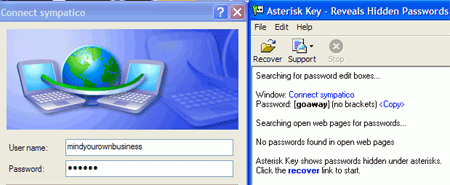The one we will use for the purpose of this article is
called Asterisk
Key by Passware. This easy to handle freeware program
analyzes covered passwords and reports them to you. To use it, simply open
the program, highlight the password box or open the web page containing
the covered password and click the 'recover' button.

Of course, commercial software programs are available
that can do considerably more than this, for a price. One example of this is Rixler software's Password Recovery
Toolbox
which scans
your system and enumerates all Internet explorer stored passwords, autocomplete
data (data you entered repeatedly when filling in web forms), Outlook
Express passwords, Internet login passwords, etc.
This information
is then presented to you in an easily accessible form. Scary,
but very useful for system administrators.
Getting around Windows XP user
passwords
Windows XP saves user passwords as
an encrypted numerical 'hash' - taking a password of say 'password'
and turning it into something like "HT5E-23AE-8F98-NAQ9-83D4-9R89-MU4K." This hash value is then stored
in the SAM (Security Accounts Manager) file, found in the C:\windows\system32\config
directory.
This portion of the file is then re-encrypted by the syskey utility which
considerably strengthens the encryption. The data needed to remove the
syskey encryption is stored in the SYSTEM file in the same directory. The
directory itself is invisible and inaccessible to all users except the operating
system itself while windows is running. By using an alternate operating
system that can read your disks, or by transferring your disks to another
windows machine, you can gain access to the SAM and SYSTEM
files.
Resetting XP user passwords with the
Administrator account
All versions of Windows XP include a built in account called 'administrator.'
This account has full privileges in XP, and is capable of resetting the
passwords for all user accounts. This can be a lifesaver if you have
locked yourself out of your normal user account. Use of the Administrator
account depends on which version of XP you are currently using.
With XP professional:
You will have been prompted to create a password for the
Administrator account during the installation process. If you have this password
recorded, or if you entered a blank password (commonly done, but not a
secure idea ), then
you can access the Administrator account and reset your forgotten
password.
To login as administrator: From the Welcome screen, press CTRL+ALT+DEL
twice to bring up a login window for the administrator
account.

